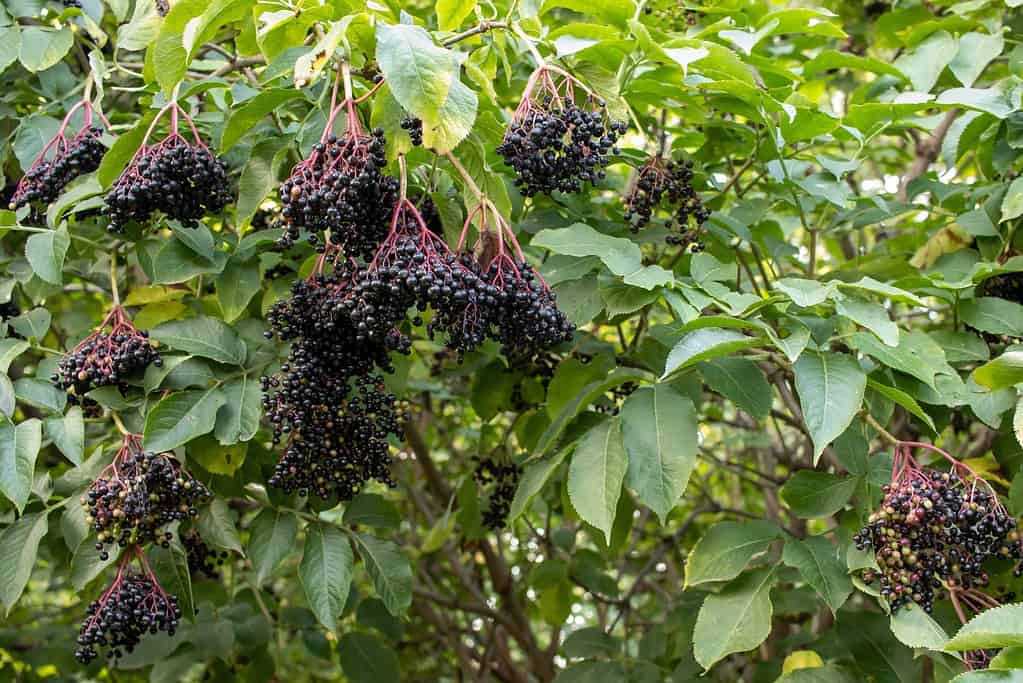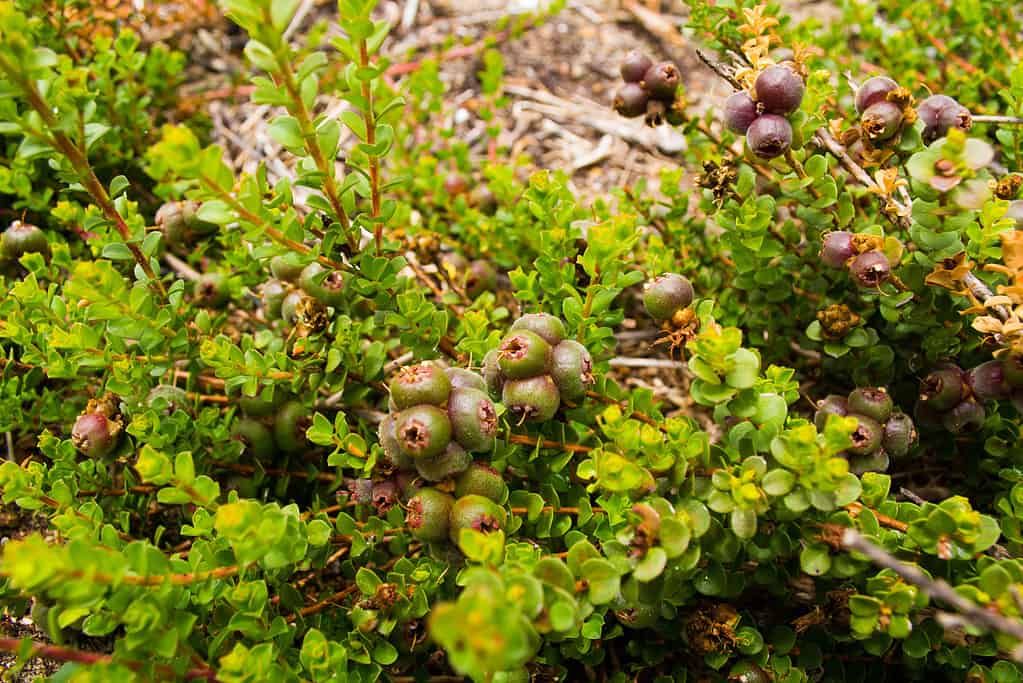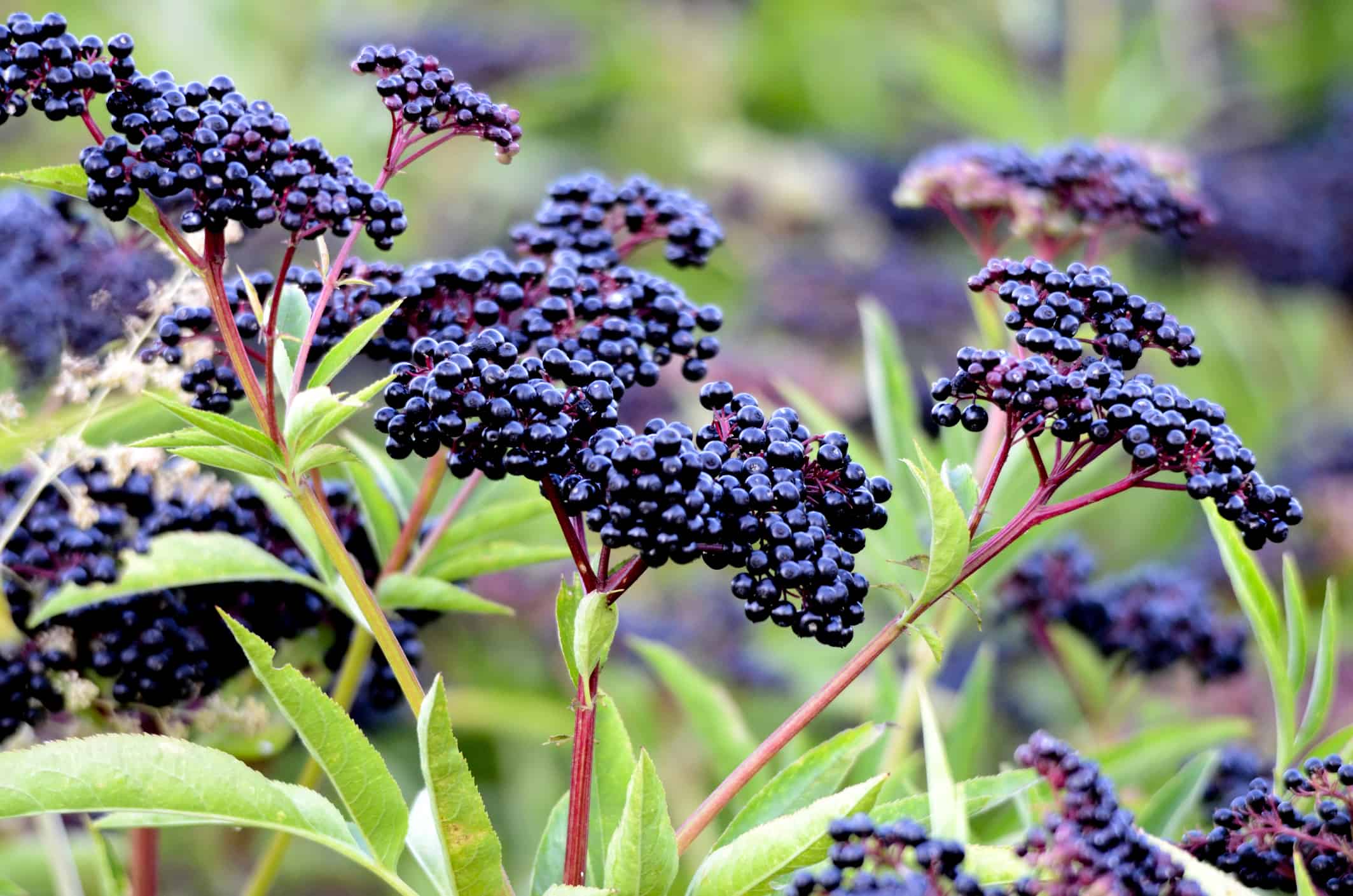Enjoying the rich world of fruits is like going on an exciting culinary journey. Every taste transports us to a world brimming with brilliant sensations, from the velvety sweetness of berries to the zingy tang of citrus.
In this article, we’ll take off on a culinary journey that is focused on the remarkable fruits that start with E, such as elderberry, eggfruit, emu apple, eucalyptus fruit, entawak, emblica fruit, ethiopian banana, eugenia fruits, elands sour fig, elephant apple fruit, earlygold mango, and etrog.
Although many of these fruits are difficult to get at the typical American grocery store, they are nevertheless interesting fruits to learn about! Read on to find out more about these amazing fruits!
1. Elderberry
We can’t have a list about fruits that start with E without mentioned the elderberry! The elder tree, formally known as Sambucus nigra, produces clusters of tiny, dark-purple berries called elderberries. These berries have a deep, rich color. They are similar in size to blueberries. They are a popular element in many different culinary recipes because of their distinctive tangy and somewhat sweet flavor.
Elderberries have been used for millennia in traditional medicine and as a food source. They are native to Europe, North America, and certain regions of Asia. They often grow by roadsides, in woodlands, and close to water sources since they do best in damp soil.
Elderberries are prized for their nutritional benefits in addition to their peculiar flavor. They contain a lot of antioxidants, especially anthocyanins, which give them their vivid color. These antioxidants support the body’s defenses against inflammation and oxidative damage. Along with minerals like potassium and iron, elderberries also include vitamins A, B, and C. They are a healthy supplement to a balanced diet since they are low in calories and high in dietary fiber.

Elderberries (pictured) are popular fruits used in traditional or natural medicine.
©Juver/Shutterstock.com
2. Eggfruit
The unique tropical fruits known as the eggfruit are shaped and sized like smal; eggs, hence their name. These fruits have smooth, glossy skin that can be either yellow or orange in hue. The flesh inside is creamy and custard-like and has a sweet and tangy flavor. The skin is thin and fragile. In addition to some regions of South America and the Caribbean, eggfruits are native to Central America, notably Mexico and Belize. They do well in warm, well-draining soil.
Eggfruits are a wonderful source of dietary fiber and include important vitamins and minerals. They boast considerable levels of vitamin A and potassium and are particularly high in vitamin C, which helps to strengthen the immune system. Eggfruits are also a healthy complement to a balanced diet because they are low in calories and fat. These unusual fruits may be eaten raw or cooked. They bring a tropical and creamy flavor to desserts, smoothies, jams, and other culinary delights.

Eggfruit (pictured) provide an excellent amount of dietary fiber.
©iStock.com/JokoHarismoyo
3. Emu Apple
Emu apples are small, spherical fruits that are native to Australia. They are a species of plant in the Kunzea genus and are native to the southern parts of the continent, mainly South Australia and Victoria. They are also known as muntries or emu berries. Aboriginal groups traditionally pick emu apples.
These unusual fruits resemble small apples in appearance. They usually have a hard texture and a diameter of about three-quarters of an inch. Emu apples mature to a waxy outer layer and can range in hue from green to red. Emu apples have a unique taste profile that combines acidity, sweetness, and undertones of spice.
In addition to being tasty, emu apples have substantial nutritional benefits. They have a brilliant color and many health advantages because they are high in antioxidants, especially anthocyanins. They also boast important minerals like calcium, iron, and potassium as well as vitamins like vitamin C. Emu apples are sometimes used in jams, sweets, and sauces because of their delicious flavor and nutritiousness.

Emu apples (pictured) are native to Australia and are used for their health benefits.
©iStock.com/VictoriaYurkova
4. Eucalyptus Fruit
This entry on our list of fruits that start with E might seem a bit unconventional, especially because this plant is mostly used for its wood. However, the gumnuts or fruit of the eucalyptus are worth noting simply because they are so interesting! Although eucalyptus trees are well known for their fragrant leaves, they do not often yield traditional human-consumed fruits. As opposed to this, eucalyptus trees produce tiny, woody capsules called gumnuts or seed pods. Despite having a large number of small seeds, these gumnuts are not regarded as a fruit that may be eaten. However, they are still sometimes referred to as eucalyptus fruit and have earned a spot on our list.
The eucalyptus tree is a native of Australia, where it dominates the landscape and serves an important ecological function. Other regions of the world where they have been introduced include regions of Asia, Africa, and South America.
Given their hardness and seed-heavy composition, eucalyptus tree gumnuts are not commonly ingested by people despite having good nutritional value. However, some eucalyptus species, including lemon-scented eucalyptus, may be utilized to make herbal beverages with a pleasant flavor and possible medicinal benefits.
Eucalyptus trees have several functions, including the creation of essential oils, the manufacturing of wood, and decorative uses. However, their gumnuts or seed pods are not thought to be a significant source of food for humans.

Eucalyptus trees (pictured) are known for their wood more than their fruits.
©Aslam 360/Shutterstock.com
5. Entawak
The tropical fruit called the Entawak fruit is indigenous to Malaysia and Indonesia in Southeast Asia. It is a member of the same family as breadfruit and jackfruit. The fruit is quite small compared to its cousins, with a maximum diameter of up to four inches. When ripe, its outer, spikey, green skin becomes yellow or brown. The Entawak fruit’s flesh is sweet, aromatic, and succulent. It has a flavor that is a cross between banana, pineapple, and mango.
The Entawak fruit has strong nutritional properties and is a rich source of dietary fiber, which helps with digestion. Just as well, it has a lot of antioxidants, potassium, vitamin C, and other vitamins and minerals. It also includes beneficial phytochemicals like flavonoids and carotenoids. This fruit is a healthy option for people limiting their calorie intake because it is low in calories and fat.
The Entawak fruit is usually consumed fresh or utilized in a variety of dishes, including drinks, jams, and desserts. It is a delicious complement to tropical cuisine because of its distinctive flavor and nutritional benefits.
6. Emblica Fruit
While the Emblica fruit is worthy of a spot on our list of fruits that start with E, it’s worth noting that these fruits are much more commonly known as amla fruit. The notably small, round Emblica fruit is indigenous to Southeast Asia and the Indian subcontinent. It is highly respected in Ayurvedic treatment and traditional Indian cuisine. It is also known as the Indian gooseberry.
Emblica fruits often have smooth, firm skin that has a pale greenish-yellow tint. Because of their acidic and sour flavor, they are often used in food preparations including chutneys, pickles, and sweets. The fruit is also ingested as a powdered supplement or in the form of juice.
In terms of nutrition, Emblica fruits are abundant in vitamin C and have a higher vitamin C content than oranges. Just as well, they have antioxidants including polyphenols, flavonoids, and tannins that support the body’s defense against free radicals. Fruits from the Embrica genus are also an excellent source of fiber, important minerals including calcium and iron, and advantageous phytochemicals.
Fruits from the Emblica genus are prized for their immune-boosting qualities and are thought to be good for the health of the hair and skin due to their nutritional profile and possible health benefits.

Emblica fruits (pictured) are known for their excellent immune-boosting abilities as well as their use as a haircare ingredient.
©iStock.com/bdspn
7. Ethiopian Banana
The large herbaceous plant known as the Ethiopian banana is indigenous to the Ethiopian Highlands. Despite not being a genuine banana, it is nonetheless referred to as one and it is part of the same family as bananas. The Ethiopian banana is easily recognized by its distinctive look, which includes a thick trunk and broad, paddle-shaped leaves that can grow to be several meters long. The shrub produces clusters of tiny, greenish fruits that are starchy and more commonly utilized in Ethiopian cuisine than as fruits to be consumed fresh.
The Ethiopian banana has noteworthy nutritional benefits. The plant is a great source of dietary fiber and improves the digestive system. It boasts calcium, potassium, vitamin C, and other necessary vitamins and minerals. These fruits are a great source of energy since they are starchy and contain lots of carbohydrates.
The plant is especially prized in Ethiopian cuisine for its pseudostem, which is collected and cooked as a staple dish known as “kocho” or “bulla.” The pseudostem is processed into a dough-like consistency after being fermented, and it is subsequently utilized in several traditional dishes.
8. Eugenia Fruits
The eugenia fruit is a tiny, rounded berry that can be red, purple, or even black. Common names for them include eugenia berries and Surinam cherries. These fruits often have a diameter similar to or slightly bigger than a cherry. They have skin that is smooth and they boast a calyx that resembles a crown.
Fruits from eugenia trees are indigenous to tropical areas, including the Caribbean and South America. They are grown in nations including Guyana, Suriname, and Brazil. The plants are tiny trees or evergreen shrubs that do well in warm regions with well-draining soil.
These fruits are renowned for their distinctive taste, which has been described as a blend of acidity and sweetness. They are abundant in vitamin C, with just a few fruits offering a sizeable amount of the daily recommended amount. Minerals including calcium and phosphorus, dietary fiber, and antioxidants are also found in eugenia fruits. They are also low in calories, which makes them a healthy and energizing option for a snack or as a component in a variety of gourmet dishes.

Eugenia fruit (pictured) are tasty fruits that have a ton of vitamin C.
©iStock.com/Murilo Gualda
9. Elands Sour Fig
This succulent plant endemic to South Africa is known as the Elands sour fig. This coastal variety, often known as the giant sour fig, does well in sandy and rocky locations.
The fleshy, triangular leaves of the Elands sour fig are gray-green in hue and have little hairs on them. Throughout the summer, the plant produces colorful, eye-catching blooms in hues of pink, purple, or orange. The edible fruit produced by the blooms are tiny, rounded berries with a juicy and tart flavor.
In terms of nutrition, Elands sour figs are an excellent source of minerals including calcium and magnesium as well as vitamins, notably vitamin C. They help with digestion since they are high in dietary fiber and low in calories. Antioxidants found in sour figs also aid in preventing oxidative stress.
These fruits are consumed raw, in jams, in salads, and in desserts. The Elands sour fig contributes to a balanced and healthy diet by offering nutritional benefits in addition to being a delicious pleasure.
10. Elephant Apple Fruit
Elephant apple fruits, often referred to as chulta or wood apples, have a very distinctive look. They have a huge, elongated shape and a tough, woody shell. The skin of this fruit is thick and tough, and it can be either green or brown in color. It has a delicate, pulpy inside that is light yellow or brownish when it is broken open. A gelatinous material surrounds the fibrous pulp within the fruit.
Elephant apple fruits are indigenous to Southeast Asia, notably India, Bangladesh, and Myanmar. They often inhabit woodlands and man-made orchards and flourish in tropical climates.
Elephant apple fruits are an excellent source of dietary fiber, vitamins, and minerals. They supply vital minerals including iron, calcium, and phosphorus, as well as vitamin C, which promotes immunological function. The pulp’s antioxidant qualities are also worth noting. The fruit’s flavor can be characterized as a blend of sweet, tart, and acidic. It is often used in classic dishes and drinks, such as jams, juices, and chutneys.

Elephant apple fruit is often used to make curry or chutney (pictured).
©iStock.com/Arnav Ray
11. Earlygold Mango
The earlygold mango is a tropical fruit recognized for its vivid color, distinctive flavor, and nutritional benefits. This particular mango type is mostly farmed in Florida in the United States.
Earlygold mangoes are oval-shaped, medium-sized fruits. They have skin that is smooth and golden with sporadic crimson flushes. The flesh has a thick, buttery texture and is juicy, sweet, and fragrant. The fruit is well-known for having a fantastic taste profile.
Earlygold mangoes are a great source of vitamins and minerals when it comes to nutrition. They have particularly high vitamin C concentrations, which strengthen the immune system. Earlygold mangos are low in fat and calories. They also provide dietary fiber, which helps with digestion.
These mangoes are popular for their range of culinary uses. They may be eaten straight off the tree, sliced in fruit salads, blended in smoothies, or added to a variety of dishes including salsas, chutneys, and desserts. They are a cherished fruit among fans of mangos due to their delicious flavor and health advantages.
While the above-mentioned fruits that start with E are very cool, it’s worth noting that there are many other fruits that start with E as well. Take a look at a few more of them below!
More Fruits That Start With E
| # | More Fruits |
|---|---|
| 12 | Etrog |
| 13 | Elder Melon |
| 14 | Eggplant (yes, it’s technically a fruit!) |
| 15 | Evergreen Huckleberry |
| 16 | Eastern Hawthorn Fruit |
| 17 | Egusi |
| 18 | Edward Mango |
| 19 | Ensete |
| 20 | European Pear |
| 21 | Enterprise Apple |
Thank you for reading! Have some feedback for us? Contact the AZ Animals editorial team.








